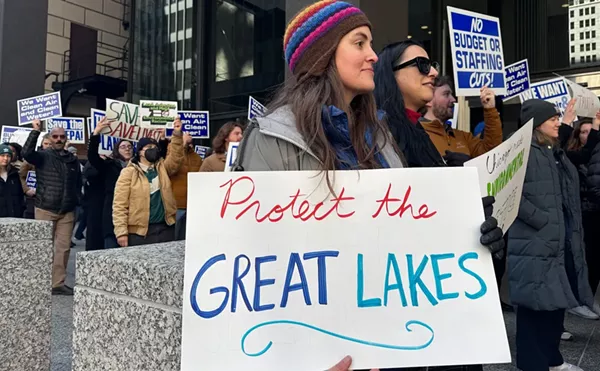Speaking frankly, we owe it to our country to do our best to put this mad cow thing in perspective. So, as loyal citizens, let’s assume that everything the government and the beef industry have told us about our first-known mad cow is true.
What that means, at the very least, is that A) on Dec. 9 the meat industry thought nothing of slaughtering — for human consumption — a cow that was so sick it couldn’t even stand up; and that B) before crucial tests on this very sick animal were complete, portions of its carcass had been shipped to Washington, Oregon, California, Nevada, Idaho, Alaska, Hawaii and even Guam; and that C) feeding dead cow brains and spines to living cows to help fatten them up was seen as normal for many years.
Yummy. Makes you want to order some chitlins and kick back with a copy of Upton Sinclair’s The Jungle, doesn’t it? Again, everything in the paragraph above has been blithely admitted by the parties involved. It is clear that our food supply is almost certainly less safe than we commonly believe, and may be a ticking time bomb that could easily lead to an environmental disaster like none we’ve ever seen.
Now there is a bit of good news . . . since August 1997, the federal Food and Drug Administration has banned feeding dead cow parts to cattle! Dead dogs and cats too! However, according to the best book on the subject, Eric Schlosser’s Fast Food Nation (HarperCollins paperback edition, 2002), the beef industry can and does still feed them “dead horses, pigs and poultry; cattle blood, gelatin and tallow, and plate waste collected from restaurants, regardless of what kind.”
You didn’t want to know that, did you? Well, too bad. Affluent America in the 21st century is a theme park that allows most of us to go our whole lives avoiding much of reality. That includes never knowing or seeing what really happens when we elect our representatives, when we flush the toilet, what death and dying are really like (till it is our turn) or what really happens on the embalmer’s table.
Most importantly, we have no idea where our dinner comes from. Gary Yourofsky, a radical vegan and animal-rights activist from Oak Park, spends his days trying to alert people to the truth, giving compelling lectures spiced up by video he has taken himself inside slaughterhouses and other “animal concentration camps.”
They aren’t for the faint of heart, but anybody planning on a non-tofu burger ought to see them anyway. Yourofsky is convinced this is far from our only mad cow.
“This has been covered up for years by the USDA,” he says, referring to the U.S. Department of Agriculture. “The real absurdity here is the downplaying of this disease by the media and the government. [They] scare people to death all the time about the flu, Lyme Disease or SARS. But when it comes to a piece of dead meat — because everybody eats it — all of a sudden the concern is slim or none. What a crock of cow shit!”
Now it is true that Yourofsky is a zealot who believes that it would be immoral for man to eat animals even if their meat were the best thing for us. Yet Schlosser, who has won awards as a correspondent for Atlantic Monthly, provides considerable evidence to back up Yourofsky’s claims. Writing last year, he noted there hadn’t then been a single case of mad cow disease detected in the United States. He also showed conclusively that the USDA hasn’t tried very hard to find it.
“Since 1990, approximately 375 million cattle were slaughtered in the United States, and about 15,000 of them were tested for mad cow.”
That means Our Government has been checking only one out of every 25,000 of the beasts we eat! That would seem to indicate that crucial life-or-death data about the food we eat is based on a considerably less reliable sample than your average Florida exit poll.
Here’s why mad cow disease (officially, Bovine Spongiform Encephalopathy) is so feared. People can get an incurable human variant called Creutzfeldt-Jakob disease, which more or less melts human brains. It’s killed at least 143 people in Great Britain since mad cow first reared its horns. Now it should be noted that the experts generally agree that you can’t get this disease by eating a steak, even from a cow that has mad cow disease.
They say you can only get it from material from the sick cow’s brain, spine or eyeballs. But less than 10 years ago, spokesmen for the cattle industry were stoutly denying that there was any scientific evidence that the disease could transmigrate from cows into humans, or indeed from any one species to another.
Now, of course, they say there is nothing wrong with feeding infected cow parts to other species, or pig brains and guts to cows meant for human consumption. Schlosser quotes John Collinge, a professor at London’s Imperial College of Medicine and an internationally recognized expert on mad cow disease, as saying this is nuts.
“All cannibalistic recycling is potentially dangerous, and I have said that repeatedly,” said the good doctor, who evidently is not a ConAgra consultant.
Events in the current mad cow scare may soon overtake this column, but we might do well to start the year by asking our presidential candidates how they propose to guarantee the safety of our nation’s food supply. They will listen to us if we yelp long and hard enough, especially now. Our nation’s food safety would be an issue worthy of a presidential campaign. This doesn’t have to be a partisan issue. It was a vigorous Republican president, Teddy Roosevelt, who led the first crusade to make sure our meat was safe. We could use a man like that again.
But it’s really up to us. Let’s see what we can do, and Happy New Year.
Jack Lessenberry opines weekly for Metro Times. E-mail [email protected]





